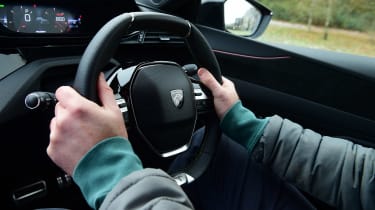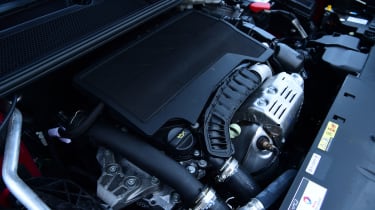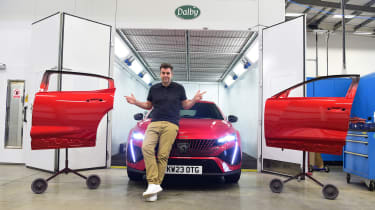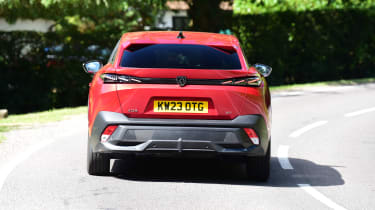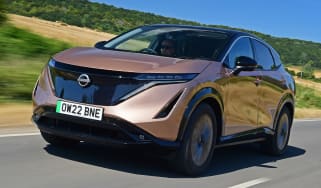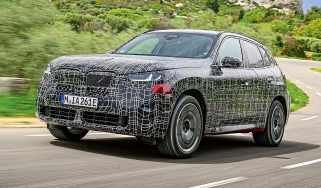Peugeot 408 GT long-term test: roomy family car, sensible small engine
Final report: six months and 4,000 miles in the 408 have been a fangtastic break from the family car norm

Verdict
The Peugeot 408 has been a great fit size-wise for my family of four, with a well thought-out cabin that’s better than you might expect in terms of design and quality. The low-speed ride is slightly firm and we’ve had one or two electrical gremlins, but the bold design certainly helps it stand out and points to growing confidence at Peugeot.
- Mileage: 4,124
- Economy: 34.4mpg
I’m not going to sugar coat this. Peugeot was a car design horror show in the early noughties. The understated, classy shape of cars such as the 405, 205, 306 and 406 Coupé gave way to amorphous blobs with the likes of the 407, 307, the original 3008 and the bonkers 1007. Happily and, somewhat ironically, Peugeot signalled the end of its design department video nasty by shocking us with a set of fangs.
Today, Peugeots look good again – to my eyes at least. The modern 208, 3008 and 508 have far more panache, and this new ethos is characterised by the firm’s striking fang-like LED daytime running lights. All of which brings me to the car I’ve been driving for the last six months, the 408. It’s possibly the boldest design of the lot.
More reviews
In-depth reviews
Road tests
The vampiric front end ties in with the rest of the Peugeot line-up, but the car itself is a mishmash of a large family hatchback, a coupé-like roof, elevated ride height and SUV-style cladding, and it’s all pulled together by a riot of sharp creases and angles. It works a lot better than it probably should, but I still feel the 408’s looks will divide opinion.
The best way to think of the 408 is as a modernisation of the large family car. Peugeot still has the 508 in that space, but the 408 borrows from the SUV formula to create a crossover four-door coupé. However you try to pigeonhole it, the 408 has worked a treat as family transport.
The 408’s rear legroom and headroom are generous, while the low boot floor makes it easy to hoist cargo inside. The space itself isn’t very tall because of the shallow rear window, but the floor area is deep and wide, which is great for lining up shopping bags.
The interior itself is quite gloomy, but that’s a result of the dark colour scheme rather than the amount of natural light. Our car has optional black Nappa leather, but the alternatives are dark grey fabric or a dark grey Alcantara, leather and fabric mix. There’s not a lot of scope for lightening the mood.
Indeed, Peugeot was clearly intent on creating a sporty feel in the 408, something that it largely achieves. The sharp exterior angles are carried over to the dash and door inserts, but not at the expense of practicality.
The 408 isn’t short of storage, with a big space under the central armrest, decent door pockets, a usable glovebox, a phone charging shelf and a big covered cubby in the centre console with enclosed cup-holders. I’ve never been short of places to put stuff.
Quality is also pretty good. The silver and black plastic on the centre console is slightly low rent, but materials higher up on the dash are reassuringly upmarket and soft touch, with ambient lighting on this GT version and some attractive contrasting stitching.
The infotainment system is impressive, too. The main touchscreen is supported by the bank of large, programmable ‘i-Toggle’ buttons below. If you’re using Android Auto or Apple CarPlay, one of these allows you to quickly swap to your phone’s interface.
On the touchscreen itself, some of the controls are small, while the animations don’t add much, other than disguising the occasionally slow responses. The 3D instrument cluster looks smart, too, but it’s failed on two occasions, with all the numbers disappearing. A restart fixes it, but leaves you guessing your speed until you’ve switched out of 3D mode. Our car’s connection to its radio antenna also failed.
The only other issue we’ve encountered has actually enhanced the driving experience. The stop-start system is working less frequently – a combination of cold weather and short urban trips being the likely cause – but this has also eliminated the delay in power delivery when getting off the line. I had wondered if it was the otherwise-smooth EAT8 gearbox or the stop-start that caused hesitation at junctions, but now I know.
While it’ll cost me a few MPG, I won’t be rushing to the dealer to see if there’s a fix. You can turn stop-start off manually, of course, but you have to do it every time you start the car.
Peugeot 408 GT: third report
Does a small engine have the ponies to power a big car?
- Mileage: 3,577
- Economy: 35.8mpg
Horsepower is very important in a car. You’re not going anywhere without it. Good old BHP helps bring acceleration and speed, the ability to shrug off inclines, surge through overtakes and not grind to a shuddering halt when the car’s boot and the seats are fully loaded.
But our Peugeot 408 is a big car with a small 1.2-litre engine, a combo that can set alarm bells ringing, given the historical connection between engine size and power.
Of course, that link between cubic capacity and BHP isn’t as robust as it once was. Small turbocharged petrol engines
like Peugeot’s 1.2-litre PureTech are nothing new in large family cars, and the rise of electrification has muddied the waters even further. Small can be mighty, and while I probably wouldn’t go quite that far when describing the 408’s power unit, the balance between performance and efficiency is better than lots of prospective buyers might be imagining.
The 1.2 PureTech engine in the 408 pumps out 128bhp at 5,500rpm, and I’ll admit to very rarely reaching those upper limits of the rev range to experience it. For a start, it’s got a healthy 230Nm of torque at 1,750rpm, so you aren’t required to stomp on the throttle in order to make progress in the 1,392kg 408. With gentle inputs, the eight-speed automatic gearbox shifts up early and almost imperceptibly, the car slurring its way around without much fuss.
If you do prefer a sportier driving experience, things unravel a little bit. The engine is an in-line, three-cylinder turbo unit and it actually sounds a lot better than you’d expect; it’s just not as fruity at higher revs as some engines of the type. Rev it out and it’s mainly an increase in volume that’s generated. In what could almost be seen as an admission of exactly this by Peugeot, there’s an artificially augmented engine sound that’s pumped through the speakers if you select Sport mode. It seems to add a bit more bass, but to be honest I always find such things slightly depressing.
To further ward you off from spirited driving in the 408, the gearbox can get flummoxed if you attempt to make faster progress. Generally, I’ve been very impressed by the smoothness of the EAT8 transmission, but it does take a fraction
of a second to get its act together when you try to make quick getaways from traffic lights or when pulling out of junctions. It means that gaps in traffic are that bit harder to judge than they need to be.
The 408 has something of a mixed character in this respect. That’s because, while the powertrain and gearbox reward
a relaxed approach, Peugeot has adopted a relatively stiff suspension set-up and the small steering wheel that’s familiar from other Peugeot models with the i-Cockpit instrument layout, adding a sporty edge.
I like the steering wheel. It feels good in the hands and, at just over six feet tall, I can achieve a comfortable driving position without it blocking the instruments – just about. Together with the firm – but not uncomfortable – ride, it does lead you to expect a sharpness to the 408’s handling that never really materialises, though.
Comfort improves as you gain speed and the steering that’s extremely light around town gains weight to inspire some confidence. It makes the 408 a very relaxing motorway car, and at a steady 70mph, the engine is nice and hushed.
What I’m driving at here, so to speak, is that I don’t think the engine in the 408 should be a deterrent for buyers at all, given the car’s strengths. Some more power is always nice, but the plug-in hybrid options, which are the only other choices in the 408 are so much more expensive – nearly £9,000 extra, even for the cheaper 178bhp option – that they’re not worth it.
The hybrid also has 65 litres less boot space and weights 300kg more. While it will go from 0-62mph faster – 8.1 seconds, rather than our car’s 10.4 seconds – you’re not going to get a lot more enjoyment out of the driving experience.
Efficiency is always going to be a factor, and while small engines tend to deliver better economy, that’s not always the case when they’re tasked with hauling around a big car. Indeed, we’ve been averaging 35 to 37mpg in around 3,000 miles of driving. It’s down on the 41-48mpg figures that the official test generate, but not by a shocking amount. As tends to be the case, the plug-in hybrid’s official numbers of 215 to 270mpg look amazing, but would require you to charge more regularly than the Light Brigade.
The message? Don’t be automatically put off by small engines in big cars. Technology has moved on, and these days it’s more salient to ask whether a car can do what you need it to, rather than how big the engine is.
The 1.2-litre Peugeot 408 isn’t quick or particularly exhilarating, but it’s a competent and (I think) quite stylish family car that certainly doesn’t have me driving around longing for another 50bhp.
Peugeot 408 GT: second report
An anonymous car park prang has put our family car out of commission
- Mileage: 2,643
- Economy: 37.0mpg
There’s been an accident. The Peugeot 408 was sitting in a public car park, minding its own business, when it had an altercation with a mystery white vehicle.
The driver, possibly unaware or prioritising their own no-claims bonus, disappeared from the scene leaving only a chalky paint residue on the 408’s freshly restyled Elixir Red bodywork. The result: deep scrapes and dents down both the 408’s passenger side doors and a trip back to Peugeot HQ for a set of replacements.
It’s the kind of thing that happens every day to car owners around the country but that doesn’t dampen the frustration and annoyance when it happens to you. There is, of course, very little that can be done when you return to a damaged car with no note on the windscreen. Depending on where you’ve parked, you’ll be lucky if CCTV cameras yield the kind of evidence that would prop-up an insurance claim. You may have a better chance with your own ‘parking mode’-equipped dash cam watching over your car.
Obviously, leaving the scene of an accident is a crime but in an age where the police scarcely have the resources to attend incidents of shoplifting where the culprit is caught in the act, you can guess where lightly, if expensively, damaged cars sit in the heap of priorities.
With the 408 back at base being restored, it gives me time to reflect on the first few months with the car.
First, it attracts a fair bit of attention for a family-sized Peugeot. Treading the increasingly crowded line between hatchback and SUV, the 408 is something different for Peugeot, and the company hasn’t held back on the design front.
Personally, I’ve got a lot of time for the current Peugeot range – the 208 and 508 in particular are great-looking cars and the 408 takes that family face, complete with ‘fang’ running lights, applying it to a body smothered in crisp angles. Our car’s doors may have gained a few unwanted extra angles in its car park collision but before that it was certainly turning heads.
Next, there is no rear wiper on the Peugeot 408. This hasn’t been too much of an issue through the summer months but we’re starting to get into the colder, wetter time of the year and manually wiping the back window clear of moisture in the morning is becoming tiresome. Our car has the ‘360-degree Vision’ option, with its four external cameras, and while I don’t usually find such systems particularly helpful, the £450 outlay seems more worthwhile here.
The 408 is a large car. At 4,687mm long, it’s generously sized for a family of four and significantly more spacious than Peugeot’s 3008 SUV – something you don’t appreciate from the sleek looks. Even the seven-seat 5008 SUV is 46mm shorter.
We’ve been loaned a 3008 while the 408 is having its doors re-attached, and after the reduction in roominess, the thing I noticed was the ride. The 408 has quite a firm suspension set-up, where jitters from the road surface make their way into the cabin much more prominently than in the 3008, which takes a softer, bouncier approach.
You can see Peugeot’s thinking, with the 408 being a lower, sporty-looking model, but the car’s steering and the body control aren’t really on the same dynamic page as the suspension. It may have been better to soften things up and shift the dial towards ride comfort.
Peugeot 408 GT: first report
Peugeot's boldly styled hatch joins our fleet and heads straight out on a seaside holiday
- Mileage: 1,250
- Economy: 43.5mpg
The Peugeot 408 is a relative newcomer to the Auto Express fleet, but it already feels like we’re old friends. It arrived fresh from Peugeot spotlessly clean, waxed and buffed, then days later I (not quite as thoroughly groomed) took it off for a family holiday to South Wales.
We returned and were soon back into the swing of normal daily life, but as many parents returning from a week away will recognise, the Peugeot 408 had gained some weight: around 3kg of sand strewn around the interior. Take nothing but photos and leave nothing but footprints, they say, but our family had seemingly managed to acquire a sizable chunk of the beach from Three Cliffs Bay on the Gower Peninsula.
Cleaning out any car after a week-long trip to the beach is never much fun, but it’s even less so when every textile seems to have been laced with fine grains of sand and your only weapons are a dustpan, brush and asthmatic Black & Decker Dustbuster from the early nineties. I am just thankful that our top-spec GT version has the optional Mistral Black Nappa leather upholstery that doesn’t cling on to sand grains with the same tenacity as the lesser Alcantara or fabric trim options, or the carpets.
The GT trim is the most expensive in the current 408 range, at just under £2,500 more than the mid-spec Allure Premium, but it does further raise the game of the impressive interior. The dashboard, centre console and floor mats have green stitching that really stands out against an otherwise dark colour scheme, and the ambient lighting offers a choice of eight colours to brighten things up at night.
The big talking point inside, however, is the 3D instrument cluster exclusive to GT models. The set-up projects speed and rpm information in hologram form in front of the dials. It looks suitably fancy and the information moves, appearing to get closer to the driver if it’s deemed important or urgent by the car’s systems. Unfortunately, the hologram has already failed once, leaving me looking at blank dials. The old ‘turn it off and on again’ trick didn’t work initially, but next morning it was all back to normal and the issue hasn’t recurred.
GT trim also includes a heated leather steering wheel, a powered tailgate and the Driver Sport Pack that allows sportier settings for the steering, throttle response, gearbox and the artificial engine sound. Outside, there’s a unique design for the 19-inch wheels, matrix LED headlights with five configurations and 3D LED rear lights.
While you can get an entry-level Allure- spec 408 for just over £31,000, our GT car with the most affordable 1.2-litre PureTech petrol engine and standard EAT8 automatic gearbox is £34,825. The only options on our car other than the leather trim are the Elixir Red paint (£850), the 360-degree camera system (£450), a wireless phone charger (£100) and the Drive Assist 2.0 pack (£500) that adds semi-autonomous lane changes and intelligent speed assist.
I’m not sure I’d class any of those as essential, although the paint definitely adds to the look of the 408 – a car that is quite colour-sensitive to my eyes.
It all takes our model up to £39,025, but if you want a plug-in hybrid, you’ll need another £8,475. The lower running costs will still take a while to recoup that.
The 408 is a difficult car to pin down. Like many brands, Peugeot has responded to the popularity of SUVs by building SUV design elements into its family-sized hatchback. The result is a large, practical machine that easily swallows a family of four and a holiday’s worth of luggage, but can be considered alongside a diverse set of rivals.
More spacious hatches such as the Skoda Octavia and Honda Civic might be seen as rivals, as could more style-led compact SUV options like the Cupra Formentor, Mercedes GLA or BMW X2. Lots will depend on how you feel about the bold looks, but life so far with the 408 has been a beach.
| Model: | Peugeot 408 GT 1.2 PureTech 130 EAT8 |
| On fleet since: | July 2023 |
| Price new: | £34,825 |
| Engine: | 1.2-litre 3cyl petrol turbo, 128bhp |
| CO2/tax: | 136g/km/£180 |
| Options: | Mistral Black Nappa leather upholstery and powered front seats (£2,300), Elixir Red paint (£850), 360-degree camera system (£450), wireless phone charger (£100), Drive Assist 2.0 pack (£500) |
| Insurance*: | Group: 21E/Quote: £550 |
| Mileage: | 4,124 |
| Economy: | 34.4mpg |
| Any problems? | Instrument failure, body repair, intermittent stop-start |
*Insurance quote from AA (0800 107 0680) for a 42-year-old in Banbury, Oxon, with three points.


